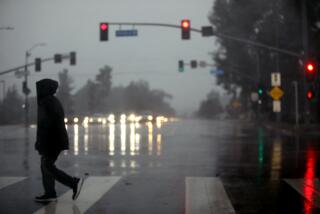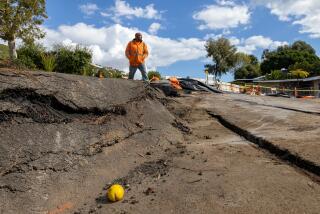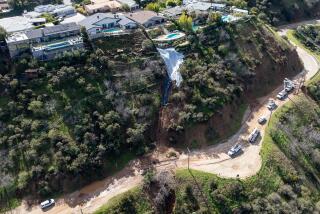On the La Crescenta mudslide line, no blast from the past -- fortunately
From her home in the high reaches of La Crescenta, Jackie Genofile watched last week as hillsides so recently denuded by fire, and so ripe for collapse, bore the new insult of rain.
County officials had cleared debris basins at the foot of canyons. Residents had rigged sandbag-and-chipboard contraptions to block a slide, like burglar bars against nature’s intrusion. All that was left was to wait.
“Everyone was pretty panicky,” Jackie said. “I was a little concerned. I kept waiting and saying, ‘OK, if it gets rough, I’ll just get in the car and leave.’ ”
The last time, though, her only warning had been silence.
The rain had come in torrents in that February of 1978, and Jackie was accustomed to hearing the resulting clatter of rock and water coursing down the culvert next to her home. But suddenly there was nothing. Maybe, she told herself, it isn’t raining as hard as I’d thought. She went back to bed.
“All of a sudden my daughter said, ‘Come here!’ ” Jackie recalled last week. Kim was in her brother’s room at the front of the house, where they watched as electrical transformers exploded on the hill rising steeply before them. “And all of a sudden, all hell broke loose -- this big black thing.”
They ran to the master bedroom, chased by the big black thing -- a surging mass of water, rock, mud and the refuse of civilization. Jackie’s husband, Bob, ordered everyone onto the mattress. But the children never got that far; they were pinned by rocks that had slid down the mountain and into the room.
“The bed was going up and up. Bob and I were on the bed, and he was trying to hold the kids’ heads up so they wouldn’t. . . .” Even now, almost 32 years later, she doesn’t finish the sentence.
And then it stopped, as they neared the ceiling: All four had survived.
Even for those who live in the flatlands, and focus their worry on earthquakes, living in California can seem to be one long attempt to thwart the will of nature. For foothill denizens like Jackie, fire and mudslides are added threats. This year the threat is acute, after the Station fire robbed the hills of the chaparral that serves as their natural glue. People who live closest to the mountains developed a crick in the neck last week, looking up and wondering: When?
It is not a short-term concern. The slide that blasted through the Genofiles’ home came three years after the fire that helped set it in motion.
::
The silence, in retrospect, was foreboding. The debris basin above their home on Markridge Road had clogged, preventing the smaller rocks from making their noisy trek down the narrow flood control channel to a catch basin below the house. Pressure built until the debris exploded out.
“Debris flow” is what the experts call it; the term “mudslide” grossly underplays reality. The slide that hit the Genofiles was composed not only of silt but of massive boulders. Thirteen cars ended up in their yard, many in the pool. Also, there were concrete lampposts, metal railings, pieces of homes, trees. It took a while to figure out the origins of the red metal wrapped around their own tree; it turned out to be someone’s Volkswagen. The slide moved swiftly; a truck racing 80 mph didn’t quite manage to outrun it.
By the time it stopped, the debris had reached the eaves, solidifying instantly. Everyone assumed that the four Genofiles were dead -- as they would have been had Bob Genofile not kicked out a glass door, giving the debris in the bedroom some release. A neighbor finally heard Scott Genofile whistling, and they were dug out by rescuers.
The four were out of their house for nine months, a period greatly shortened by the fact that Bob Genofile, who died nine years ago, was a contractor. He had built the original house so stoutly that its concrete block walls held against the assault. But, taking no chances, he added a second story before they moved back -- to place the bedrooms upstairs.
Progress is often reactive. A wildfire led to a massive slide in the same general area in 1934, which prompted the construction of debris basins. The 1978 slide was a warning to government officials to more closely monitor those basins. The Genofiles won a settlement from the county of more than $300,000, after arguing that flood control officials had botched their responsibilities. They were featured in Los Angeles Times articles, and drew additional attention when writer John McPhee focused a lengthy New Yorker article -- later included in a book -- on the Genofiles.
The county believes things have improved. In addition to community meetings, officials have contacted 400 foothill residents believed to be most in danger, given the contours of the recent fire. Scores more will be contacted soon. There is a hierarchy of threat, and concrete barriers signal the streets believed to be most at risk.
There were no concrete barriers last week on Pine Cone Road, the slide’s slalom run in 1978. There were none where Pine Cone dead-ends into Markridge, at the Genofiles’ home. The most notable deterrents are giant boulders left over from 1978. Too big to move, and cheap landscaping to boot, Jackie joked.
The recent fire, visible from her house, brought out the old fears about what comes next, about whether the debris system will hold.
“Is it possible that it could block up like it did before?” she asked. “But, on the other hand, maybe they keep a closer eye on it?”
::
The mountain occasionally gives something back. Six months after they lost almost everything they owned, Scott saw a glint in the catch basin below their house: his mother’s diamond ring. Fifteen years later, a gardener digging around Jackie’s rosebushes found her old purse, with money still inside. A year ago, a fresh rain unearthed one of the family’s plates in the basin, upside down with a crack in the middle.
But so much was lost, to the mud and to subsequent looters. The mundane things of a life: Scott’s Hot Wheels collection and daughter Kim’s Barbies. A ring that Bob had given Jackie.
“Those are little things, but they’re big things for me,” she said.
Still, she laughs more than anything. She rolls her eyes when asked her age -- though, hint, she was born in 1924. She thinks it’s nuts to say that people who live in these hills are crazy.
“It’s always something,” she said -- tornadoes in the Midwest, fires and mudslides here, take your pick. “I’m here for the long haul. And I’m enjoying every moment of it.”
In her living room, cool despite the hot autumn day, Jackie sits near a picture window talking of loss and resurrection, of California’s endless conflict between people and nature.
A plane flies past. It is a firefighting plane, destination unknown.
Each Sunday, The Week examines implications of major stories. It is archived at latimes.com/theweek.
More to Read
Start your day right
Sign up for Essential California for news, features and recommendations from the L.A. Times and beyond in your inbox six days a week.
You may occasionally receive promotional content from the Los Angeles Times.







